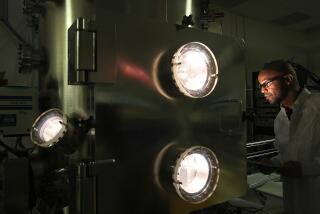Hughes Shifting Attention Away From Defense : Aerospace: The planned reorganization by the Los Angeles-based firm is another sign of the impact of military budget cuts.
- Share via
Hughes Aircraft Co., the world’s largest defense electronics contractor, will reorganize its operations to help achieve its long-term goal of shifting more of its production to commercial applications, the company said Monday.
Although it will involve no layoffs, the Hughes restructuring is another manifestation of defense budget cuts that have cost the 1.23-million-employee aerospace industry more than 101,000 jobs since 1989, according to the Washington-based Aerospace Industries Assn.
Loss of defense work has prompted other aerospace companies, such as Lockheed and Rockwell International, to increase the percentage of their commercial work as well. Lockheed plans to reduce the percentage of its U.S. defense work from 73% to 60% in five years. Rockwell’s defense work has dropped from 50% to 25% since 1987.
Analysts applauded the Hughes reorganization, saying it shows that the company is serious about reducing its dependence on defense. The stock of Hughes’ parent, GM Hughes Electronics Corp., closed unchanged Monday at $18.75 on the Big Board.
Los Angeles-based Hughes also announced Monday that the long-planned retirement of President and Chief Operating Officer D. Kenneth Richardson will become effective Aug. 1. No immediate successor was named.
Hughes, which has been moving more into the non-defense arena since Malcolm R. Currie took over as chairman and chief executive in 1988, will replace seven operating groups with three broader-based divisions, according to spokesman Richard Dore.
Under the old setup, all seven operating groups performed a mixture of defense and non-defense work. The realignment will separate most of the defense from non-defense work.
The reorganization also involves establishing an office of the chairman to run Hughes. In addition to Currie, it will include Executive Vice President and Chief Financial Officer Michael T. Smith, Executive Vice President James A. Abrahamson and senior vice presidents Richard D. Brandes, Anthony J. Iorillo and W. Scott Walker.
Currie said separating commercial from defense activities will help its non-defense programs compete better.
“You just can’t put these (commercial) activities into the middle of a defense business or a government business,” he said, without bogging them down with “requirements imposed on the business by the government,” such as paper work and auditing.
Dore said Hughes, with 44,000 employees one of the largest private employers in Southern California, earned 80% of its revenue from defense activities in 1988. That percentage is down to 70%, and the goal is to reduce it to 50% by 1995.
The drop in defense work prompted the company to cut 9,000 jobs in 1989. No reductions occurred in 1990, but the company announced several months ago that it is eliminating 3,000 positions this year.
An example of Hughes’ movement from defense to commercial work is the fact that the world’s largest supplier of air defense systems is building a $325-million air traffic control system to handle all of Canada’s commercial flights, Dore said.
The company has more than 150 small programs going with GM, he added. The auto maker uses infrared Hughes technology to make sure paint is applied evenly on its cars, for example. And an acoustic-based Hughes system allows GM to diagnose transmission problems with sound waves.
Hughes’ biggest commercial success story has been in satellite building. It is the world’s largest satellite manufacturer, with $2 billion in sales projected for this year.
Aerospace analyst Lawrence M. Harris at Bateman Eichler in Chicago termed Hughes’ reorganization “a logical extension of a previously announced strategy” of reducing its defense work.
He pointed out that the company’s work on such defense projects as the Maverick and Phoenix missile and radar systems for the F14 and F15 fighter is winding down.
In fact, Hughes decided not to join a group of companies that bid on the advanced tactical fighter’s radar system, he said. “They were unwilling to participate in the (developmental) cost sharing,” he said.
As a result, he said, Westinghouse won the contract.
Hughes Aircraft at a Glance Headquarters: Los Angeles
Employees: 66,000 worldwide, 44,000 in Southern California.
Chief executive: Malcolm R. Currie
Main businesses: Defense, aerospace, satellites, telecommunications and electronics.
1990 sales: $7.82 billion. (General Motors, Hughes’ parent, declines to reveal the profit figures of its subsidiaries).
Source: Hughes Aircraft Co.
More to Read
Inside the business of entertainment
The Wide Shot brings you news, analysis and insights on everything from streaming wars to production — and what it all means for the future.
You may occasionally receive promotional content from the Los Angeles Times.










